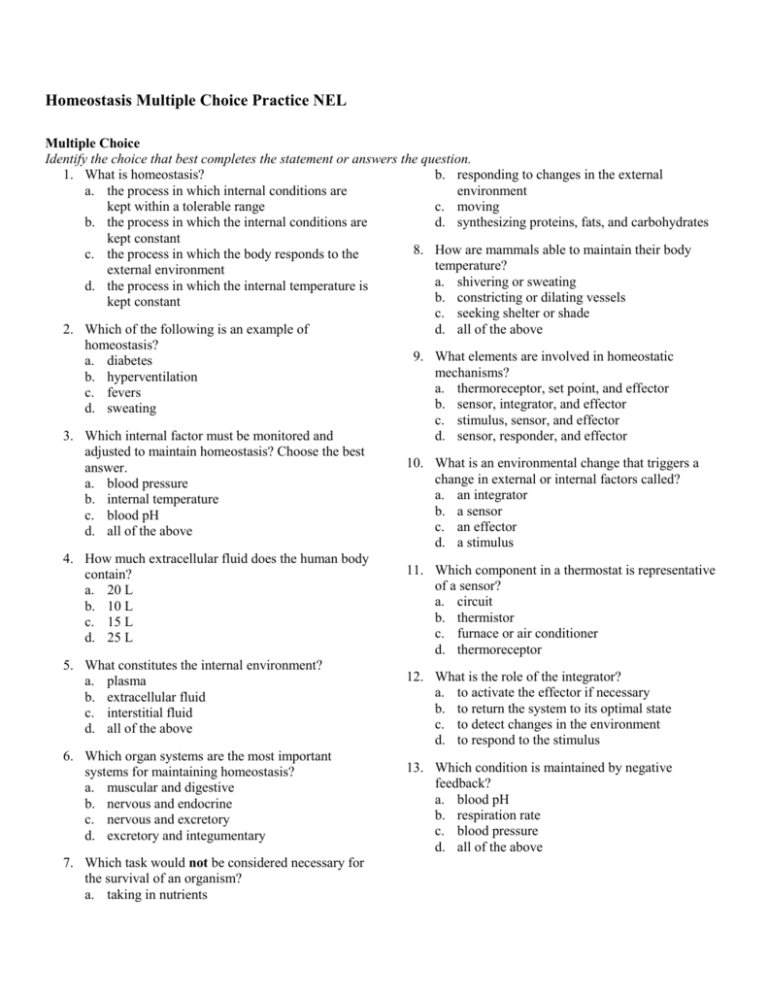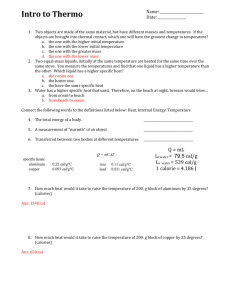Homeostasis Multiple Choice Practice NEL
advertisement

Homeostasis Multiple Choice Practice NEL Multiple Choice Identify the choice that best completes the statement or answers the question. 1. What is homeostasis? b. responding to changes in the external a. the process in which internal conditions are environment kept within a tolerable range c. moving b. the process in which the internal conditions are d. synthesizing proteins, fats, and carbohydrates kept constant 8. How are mammals able to maintain their body c. the process in which the body responds to the temperature? external environment a. shivering or sweating d. the process in which the internal temperature is b. constricting or dilating vessels kept constant c. seeking shelter or shade 2. Which of the following is an example of d. all of the above homeostasis? 9. What elements are involved in homeostatic a. diabetes mechanisms? b. hyperventilation a. thermoreceptor, set point, and effector c. fevers b. sensor, integrator, and effector d. sweating c. stimulus, sensor, and effector 3. Which internal factor must be monitored and d. sensor, responder, and effector adjusted to maintain homeostasis? Choose the best 10. What is an environmental change that triggers a answer. change in external or internal factors called? a. blood pressure a. an integrator b. internal temperature b. a sensor c. blood pH c. an effector d. all of the above d. a stimulus 4. How much extracellular fluid does the human body 11. Which component in a thermostat is representative contain? of a sensor? a. 20 L a. circuit b. 10 L b. thermistor c. 15 L c. furnace or air conditioner d. 25 L d. thermoreceptor 5. What constitutes the internal environment? 12. What is the role of the integrator? a. plasma a. to activate the effector if necessary b. extracellular fluid b. to return the system to its optimal state c. interstitial fluid c. to detect changes in the environment d. all of the above d. to respond to the stimulus 6. Which organ systems are the most important 13. Which condition is maintained by negative systems for maintaining homeostasis? feedback? a. muscular and digestive a. blood pH b. nervous and endocrine b. respiration rate c. nervous and excretory c. blood pressure d. excretory and integumentary d. all of the above 7. Which task would not be considered necessary for the survival of an organism? a. taking in nutrients 14. Which of the following is an effector activated by the hypothalamus when the temperature of the body is lower than the set point? a. sweat glands initiate sweating b. move to a warmer location or put on a sweater c. skeletal muscles contract d. skin blood vessels dilate 15. What is an example of positive feedback? a. labour contractions during birth b. an air conditioner turns on when the temperature rises c. sweating when you are hot d. increased respiration during exercise 16. What are thermoreceptors? a. receptors that detect deviations from an internal set point temperature b. receptors that adjust the rate of exothermic reactions c. receptors that adjust the rate of thermal energy exchange through the body’s surface d. all of the above 17. How is thermal energy transferred through sweating? a. evaporation b. convection c. radiation d. conduction 18. Cold air displaces warmer air. What does this involve? a. conduction b. evaporation c. convection d. radiation 19. What is a poikilotherm? a. a group that includes mammals and birds b. an animal whose body temperature varies with the external environment c. an animal that can maintain a stable body temperature regardless of external conditions d. all of the above 20.How could you classify an animal that behaviourally regulates its body temperature during the daytime? a. homeothermic endotherm b. poikilothermic ectotherm c. homeothermic ectotherm d. poikilothermic endotherm 21. By which method(s) of thermal energy transfer do amphibians regulate their body temperatures? a. conduction and radiation b. conduction c. radiation d. conduction and convection 22. Why is an ectotherm likely to survive longer without food than an endotherm of equal size? a. the ectotherm has a higher metabolic rate b. the ectotherm does not use energy to regulate its temperature c. the ectotherm expends more energy than the endotherm d. the ectotherm is better able to metabolize its stored energy 23. What is an example of thermal acclimatization? a. a lizard sunning itself on a rock b. freshwater fish moving to deeper waters during hot summer days c. the Galapagos marine iguana increasing the blood flow to exposed areas of skin d. the wood frog spending winter in a frozen state 24. Which of the following would use panting behaviour? a. an endotherm that needs to cool down b. an ectotherm that needs to warm up c. an ectotherm that needs to cool down d. an endotherm that needs to warm up 25. Which animals hibernate? a. squirrels b. hummingbirds c. bears d. lungfish 26.Why does the water move in the direction shown in the diagram? 28.What is osmoregulation? a. the regulating of osmotic pressure in bodily fluids and cells b. the regulating of water in cells c. the regulating of hydrostatic pressure in bodily fluids and cells d. all of the above 29. Which animals produce urea? a. cartilaginous fishes b. insects c. bony fishes d. birds a. The water moves to the area where the concentration of the solute is low. b. The water moves from an area of high water concentration to an area of low water concentration. c. The water moves from an area where the solution of the solute is high. d. The water moves from an area of low water concentration to an area of high water concentration. 27. What condition does the diagram show? 30. What form of waste nitrogen is shown below? a. b. c. d. uric acid nucleic acid urea ammonia 31. Which organs are involved in the human excretory system? a. kidneys, bladder, ureters, and urethra b. liver and pancreas c. liver, kidneys, and bladder d. sweat glands and skin a. The solution on the left side of the membrane is isoosmotic. b. The solution on the left side of the membrane is hyperosmotic. c. The solution on the left side of membrane is hypoosmotic. d. The solution on the right side is hyperosmotic. 32. What would happen if a squid were mistakenly put in freshwater? a. It would be hyperosmotic to the freshwater and could not osmoregulate. b. It would be hypoosmotic to the freshwater and could not osmoregulate. c. Its cells would dehydrate. d. It could not handle the change in osmotic and hydrostatic pressures. 33. In relation to the seawater around them, lobsters and other marine invertebrates are a. hyperosmotic. b. isoosmotic. c. hypertonic. d. hypoosmotic. 34. How and where is urea formed from ammonia? a. the ammonia combines with HCO3– in the liver b. the ammonia combines with uric acid in the bladder c. the ammonia combines with water in the bladder d. the ammonia combines with HCO3– in the kidney 38.How do saltwater birds excrete excess salt? a. salt is removed from the blood through active transport b. they have specialized salt glands in their heads c. a salty secretion exits through the nostrils d. all of the above 39. What organ is represented by A in the diagram? 35. What is the advantage of excreting urea rather than ammonia as waste? a. urea is less toxic than ammonia b. urea requires less water for excretion c. urea is very soluble d. all of the above 36. What organ is represented by A in the diagram? a. b. c. d. a. b. c. d. hemolymph bladder kidney metanephridium urethra kidney ureter urinary bladder 40. What organ is represented by A in the diagram? 37. What organ is represented by A in the diagram? a. b. c. d. kidney hemolymph metanephridium bladder a. b. c. d. ureter kidney urethra urinary bladder 41.The following diagram shows the internal structure of a human kidney. What part of the kidney is represented by A? 44.Where does the filtrate go from the distal convoluted tubule? a. Bowman’s capsule b. proximal convoluted tubule c. loop of Henle d. collecting duct 45. What causes kidney stones to form? a. a buildup of cholesterol b. a buildup of mineral solutes combined with calcium c. a buildup of mineral solutes, such as oxalates, phosphates, and carbonates d. a buildup of calcium a. b. c. d. renal cortex ureter renal medulla renal pelvis 42. What part of the kidney is represented by A? a. b. c. d. ureter renal medulla renal pelvis renal cortex 43. What part of the kidney is considered to be the functional unit? a. renal medulla b. nephron c. glomerulus d. Bowman’s capsule Homeostasis Multiple Choice Practice NEL Answer Section: MULTIPLE CHOICE 1. 2. 3. 4. 5. 6. 7. 8. 9. 10. 11. 12. 13. 14. 15. 16. 17. 18. 19. 20. 21. 22. 23. 24. 25. 26. 27. 28. 29. 30. 31. 32. 33. 34. 35. 36. 37. 38. 39. 40. 41. 42. 43. ANS: ANS: ANS: ANS: ANS: ANS: ANS: ANS: ANS: ANS: ANS: ANS: ANS: ANS: ANS: ANS: ANS: ANS: ANS: ANS: ANS: ANS: ANS: ANS: ANS: ANS: ANS: ANS: ANS: ANS: ANS: ANS: ANS: ANS: ANS: ANS: ANS: ANS: ANS: ANS: ANS: ANS: ANS: A D D C D B C D B D B A B C A D A C B C A A D A A B B A A A A A B A D B C D B A C D B 44. ANS: D 45. ANS: B








